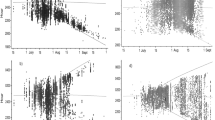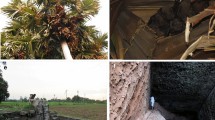Summary
-
1.
The activity cycle in a colony of about 150 pond bats is studied throughout the summer season in Berlikum (Netherlands). The natural diurnal roosts of the bats are sited between rafters of a church loft where a nocturnal darkness reigns day and night. The onset of activity generally takes place in two phases: I—descending into and waiting in a narrow exit chamber from where daylight can be seen, II—flying out to the feeding grounds. The investigation includes electronic recording of passages of bats, and of light intensity during morning and evening twilight.
-
2.
Phase I is regulated by an endogenous circadian timing system which is synchronised to the seasonal variation in daylength. The main entraining agent is daylight which the fats can only have observed, either when waiting in the exit chamber at dusk on the preceding day, or when flying home at dawn. The large time lapse occurring between the moments of arrival of first and last descender in the exit chamber (2 hrs), and between the return of the first and last homeflyer (1 hr) on a given day, is ascribed to lack of precision in timing of the right moment. This lack is thought to originate from two facts. First, the almost dayly variation of cloudiness of the sky at the time of departure causes the rate of decrease of daylight to fluctuate irregularly. Second, at the times of departure and return most of the bats are confronted with very low light intensities only being poor entraining agents. In addition, there is some evidence that each individual has an oscillatory entrained activity cycle causing it to be among the first descenders (homeflyers, resp.) at one day, among the last descenders (homeflyers, resp.) at another day. Some relevant literature data on responsecurves concerning other nocturnal mammals are discussed.
-
3.
The seasonal phase relationship between the daylight cycle and the actiiity rhythm observed in pond bats accords with the Aschoff-Wever model, but only as far as the light-dark ratio is concerned. Twilight duration does not seem to be an important factor in this respect. The value of light intensity at the moment of departure of the first outflyer decreases as the season proceeds.
-
4.
Phase II (the flying out) is regulated grosso modo by the absolute value of light intensity at the moment of departure. It is made plausible that the releasing stimulus for departure of the first outflyer, on clear evenings, is the surpassing of a threshold value of the rate of relative decrease of light intensity.
-
5.
Literature data on activity cycles of other bat species are discussed.
Similar content being viewed by others
References
Aschoff, J.: Exogenous and endogenous components in circadian rhythms. Cold Spr. Harb. Symp. quant. Biol. 25, 11–28 (1960)
Aschoff, J.: Die Tagesperiodik licht- und dunkelaktiver Tiere. Rev. suisse Zool. 71, 528–558 (1964)
Aschoff, J.: Phasenlage der Tagesperiodik in Abhängigkeit von Jahreszeit und Breitengrad. Oecologia (Berl.) 3, 125–165 (1969)
Böhme, W., Natuschke, G.: Untersuchung der Jagdflugaktivität feilebender Fledermäuse in Wochenstuben mit Hilfe einer doppelseitigen Lichtschranke und einige Ergebnisse an Myotis myotis (Borkhausen, 1797) und Myotis nattereri (Kuhl, 1918). Säugetierk. Mitt. München 2, 129–138 (1967)
Daan, S.: Periodicity of heterothermy in the garden dormouse, Eliomys quercinus (L.). Neth. J. Zool. 23, 237–265 (1973)
Decoursey, C., Decoursey, P. J.: Adaptive aspects of activity rhythms in bats. Biol. Bull. mar. biol. Lab., Woods Hole 126, 14–27 (1964)
Decoursey, P. J.: Effect of light on the circadian activity rhythms of the flying squirell, Glaucomys volans. Z. vergl. Physiol. 44, 331–354 (1961)
Decoursey, P. J.: Function of a light response rhythm in hamsters. J. cell. comp. Physiol. 63, 189–196 (1964)
Engländer, H., Laufens, G.: Aktivitätsuntersuchungen bei Franzenfledermäusen (Myotis nattereri, Kuhl, 1818). Experientia (Basel) 24, 618–619 (1968)
Griffin, D. J., Welsh, J. H.: Activity rhythms in bats under constant external conditions. J. Mamm. 18, 337–342 (1937)
Laufens, G.: Freilanduntersuchungen zur Aktivitätsperiodik dunkelaktiver Säuger. Inaug.-Diss., Köln, S. 1–87 (1972)
Nyholm, E. S.: Zur Ökologie von Myotis mystacinus (Leisl.) und M. daubentoni (Leisl.) (Chiroptera). Ann. Zool. Fenn. 2, 77–123 (1965)
Ringelber, J.: The positively phototactic reaction of Daphnia magna Straus: a contribution to the understanding of diurnal vertical migration. Neth. J. Sea Res. 2, 319–406 (1964)
Sluiter, J. W., Heerdt, P. F. van, Voûte, A. M.: Contribution to the population biology of the pond bat (Myotis dasycneme, Boie, 1825). Decheniana, Naturh. V. Rheinlande u. Westfalens, Bonn, Beiheft 18, 1–43 (1971)
Twente, J. W.: Some aspects of habitat selection and other behavior of cavern-dwelling bats. Ecology 36, 706–732 (1955)
Voûte, A. M.: Bijdrage tot de oecologie van de Meervleermuis (Myotis dasycneme, Boie, 1825). Thesis, Utrecht, pp. 1–159 (1972)
Wever, R.: Zum Einfluß der Dämmerung auf die circadiane Periodik. Z. vergl. Physiol. 55, 255–277 (1967)
Author information
Authors and Affiliations
Rights and permissions
About this article
Cite this article
Voûte, A.M., Sluiter, J.W. & Grimm, M.P. The influence of the natural light-dark cycle on the activity rhythm of pond bats (Myotis dasycneme Boie, 1825) during summer. Oecologia 17, 221–243 (1974). https://doi.org/10.1007/BF00344923
Received:
Issue Date:
DOI: https://doi.org/10.1007/BF00344923




